Disrupt Domestic Drug Trafficking and Production
Principle 2. United States Borders Must be Secured
Border regions are important transit zones for drug trafficking organizations. Targeted enforcement along the borders is a critical mechanism to prevent and disrupt the flow of drugs.
Southwest Border
A major transit zone for drugs, weapons, and money, this region requires a unique focus to effectively disrupt large scale drug operations. In recognition of the Southwest border’s significance in domestic drug trafficking, the Administration drafted the 2009 National Southwest Border Counternarcotics Strategy. This targeted strategy seeks to substantially reduce the flow of illicit drugs, drug proceeds, and associated instruments of violence across the Southwest border by enhancing intelligence capabilities; interdicting drugs, proceeds, and weapons; conducting investigations of and prosecuting significant drug traffickers; and enhancing U.S.-Mexico cooperation in joint counterdrug efforts. In the coming year, the Administration will implement the 2011 National Southwest Border Counternarcotics Strategy. This Strategy sets specific operational priorities to more effectively respond to the threats posed by drugs and drug trafficking in the southwestern United States. (Action Item 5.2A)
Implementation of the National Southwest Border Counternarcotics Strategy will also be significantly advanced by the latest step in the Administration’s comprehensive approach to securing the Southwest border: the Emergency Supplemental for Border Security (Public Law 111-230) signed by President Obama in August of 2010. It includes $600 million in supplemental funding for enhanced border protection and law enforcement activities. The law also includes $244 million to hire new and fund existing Border Patrol agents and CBP Officers; $196 million for DOJ to increase the number of Federal law enforcement officers, enhance its prosecutorial efforts along the border, and increase its training of and assistance to its Mexican law enforcement counterparts; and $80 million for new ICE agents and supporting investments in the region, along with significant funding for new detection, communications, and training systems. Additional funds are also provided for detention and incarceration of criminal aliens in coordination with DHS enforcement activities.
Also in 2010, the President authorized the temporary deployment of up to 1,200 additional National Guard troops to the border to contribute additional capabilities and capacity to assist law enforcement agencies as a bridge to longer-term enhancements in the efforts to target illicit networks’ trafficking in people, drugs, illegal weapons, money, and the violence associated with these illegal activities. These National Guard troops provide Entry Identification Teams and criminal investigation analysts in support of these efforts. Their support has allowed CBP to bridge the gap and hire additional agents to support the Southwest border, as well as field additional technology and communications capabilities that Congress provided. These deployments have provided significant results. The California National Guard provided important support to ICE agents in finding two tunnels under the border in November 2010. The discovery of the first tunnel resulted in the discovery of 30 tons of marijuana, the single largest drug seizure associated with a border tunnel. Another 20 tons of marijuana were seized upon the discovery of a second tunnel. (See box below.)
ATF is coordinating with DHS to continually improve intelligence sharing and identify opportunities for joint operations. On October 5, 2010, ATF signed an agreement with the Government of Mexico to trace all recovered weapons through ATF’s eTrace, an important step in connecting domestic intelligence and enforcement capabilities with efforts to secure the border. ATF will continue to train Mexican government personnel on the identification of firearms and usage of the eTrace system. This groundbreaking agreement will improve tracking and help disrupt the transnational flow of illegal guns used by drug trafficking and other criminal organizations.
ATF developed Project Gunrunner, a national initiative which seeks to detect, disrupt, and dismantle illicit firearms trafficking schemes and networks operating within the United States on behalf of Mexican transnational criminal organizations. Project Gunrunner uses a three-pronged approach that includes targeted criminal investigations, outreach and partnership with the firearms industry and licensed firearms dealers, and training of state, local, tribal, and Mexican law enforcement partners in state-ofthe-art firearms-trafficking techniques, firearms tracing, explosive post-blast and Improvised Explosive Device (IED) investigation. In the coming year, ATF will establish two new operational ATF Gunrunner Impact Teams to target Southwest border firearms trafficking activities, co-located when possible with existing OCDETF Strike Forces and BESTs. (Action Item 5.2C)
San Diego Tunnel Task Force
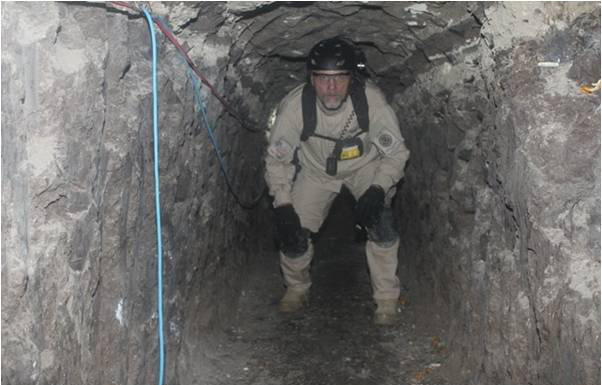 On Thanksgiving Day 2010, a multi-agency San Diego Tunnel Task Force, a unit of the San Diego BEST, discovered a major drug tunnel in a dense industrial area of Otay Mesa just north of the border. The tunnel was about 2,200 feet long, about the length of seven football fields. On the U.S. side of the border it connected to two warehouses about 800 feet apart, both east of the Otay Mesa border crossing. On the Mexican side, in Tijuana, it connected to a two-story home. Eight people—two U.S. citizens and six Mexicans—were arrested in connection with the tunnel. More than 20 tons of marijuana were seized, most of it in a tractor-trailer stopped at a Border Patrol highway checkpoint in Temecula, a few tons in the tunnel, and the rest at a ranch in Mexico. The wholesale value of the marijuana was $17 to $20 million. Drug smugglers likely spent $2 to $3 million to build the tunnel, which had flooring, lighting, ventilation systems, an expertly laid rail system, and a sizable room for storing the drugs. Authorities also said it was the first time they had seen a tunnel with two fully constructed exit points in the United States. Earlier in the same month, the Tunnel Task Force had uncovered an 1,800-foot tunnel ending at another Otay Mesa warehouse just a few blocks from the Thanksgiving Day find. That discovery also resulted in a massive seizure of marijuana—an estimated 30 tons.
On Thanksgiving Day 2010, a multi-agency San Diego Tunnel Task Force, a unit of the San Diego BEST, discovered a major drug tunnel in a dense industrial area of Otay Mesa just north of the border. The tunnel was about 2,200 feet long, about the length of seven football fields. On the U.S. side of the border it connected to two warehouses about 800 feet apart, both east of the Otay Mesa border crossing. On the Mexican side, in Tijuana, it connected to a two-story home. Eight people—two U.S. citizens and six Mexicans—were arrested in connection with the tunnel. More than 20 tons of marijuana were seized, most of it in a tractor-trailer stopped at a Border Patrol highway checkpoint in Temecula, a few tons in the tunnel, and the rest at a ranch in Mexico. The wholesale value of the marijuana was $17 to $20 million. Drug smugglers likely spent $2 to $3 million to build the tunnel, which had flooring, lighting, ventilation systems, an expertly laid rail system, and a sizable room for storing the drugs. Authorities also said it was the first time they had seen a tunnel with two fully constructed exit points in the United States. Earlier in the same month, the Tunnel Task Force had uncovered an 1,800-foot tunnel ending at another Otay Mesa warehouse just a few blocks from the Thanksgiving Day find. That discovery also resulted in a massive seizure of marijuana—an estimated 30 tons.
Northern Border
Following passage of the Northern Border Counternarcotics Strategy Act of 2010 (P.L. 111-356), Federal, state, and local enforcement agencies took steps to improve border management and reduce drug trafficking threats along the U.S.-Canada border. DHS is developing a departmental Northern Border Strategy that identifies the need for increased intelligence, information sharing, and coordination at, along, and away from the U.S.-Canada border. Similar to the BESTs, which integrate intelligence, interdictions, and investigations among participating Federal, state, local, and Canadian law enforcement agencies at the major ports of entry along the Northern Border, IBETs, composed of U.S. and Canadian Federal, state, provincial, and local law enforcement personnel, conduct intelligence-driven operations along the U.S.-Canada border between the ports of entry. The 15 IBETs in 24 locations actively share information and participate in bi-national enforcement operations. To build on these efforts, ONDCP will lead an interagency process to develop the inaugural Northern Border Counternarcotics Strategy, which will be released in 2011. (Action item 5.2D)
Securing the Borders
Additionally, DHS/ICE will expand the BEST program by adding teams in Honolulu, San Francisco, Norfolk (Virginia), San Juan, and Massena (New York). These teams will build upon the 21 existing BESTs currently in operation to better leverage the Federal, state, local, and foreign law enforcement capabilities in crucial drug trafficking regions along the borders.
Principle 3. Focus National Efforts on Specific Drug Problems
The Administration recognizes the Nation faces more than just one drug problem. Each part of the country has distinctive drug-related challenges that require unique, community-based responses. Therefore, the Strategy’s domestic enforcement objective focuses national efforts on specific drug problems.
Methamphetamine Production
One example of a regionalized threat is the domestic production of methamphetamine, which is an increasing problem in the southern and Midwestern regions of the United States. According to EPIC, during 2009 there were 10,221 laboratory seizure incidents (incidents represent seizures of dumpsites, labs, and equipment/glassware). Preliminary 2010 data indicate the number of methamphetamine lab incidents is likely to have increased, continuing an upward trend that started in 2008. While we have made gains in reducing the number of large “superlabs” operating in the United States, the overall upward trend in smaller labs is a serious concern.
The Administration continues to seek refinements to current laws and regulations to prevent and disrupt methamphetamine production. On October 12, 2010, President Obama signed the Combat Methamphetamine Enhancement Act of 2010 (Public Law 111-268), which became effective 180 days later in April 2011. This law extends to mail-order retailers the training and “self-certification” requirements previously applicable only to other retailer sellers of over-the-counter drug products containing the precursor chemicals pseudoephedrine, ephedrine, or phenylpropanolamine. It also creates two new offenses, primarily punishable by civil penalties, one for negligently failing to self-certify as required and another to distribute these over-the-counter drugs to sellers who are not self-certified: the law requires DEA to maintain a list of self-certified persons for this purpose. This law builds upon the 2006 Combat Methamphetamine Enhancement Act to ensure retailers effectively control methamphetamine precursors and handle and distribute these chemicals in a safe, responsible manner. These types of policy and regulatory solutions will enable domestic enforcement to more effectively reduce methamphetamine manufacturing in the United States. (Action Item 5.3A)
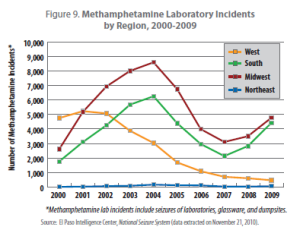
The National Methamphetamine and Pharmaceutical Initiative (NMPI)
The National Methamphetamine and Pharmaceutical Initiative (NMPI), an initiative of ONDCP’s HIDTA program, is working with state and local leaders to explore policy, regulatory, and enforcement options to reduce the availability of methamphetamine throughout the United States, as well as precursors and other chemicals to illicit methamphetamine manufacturers through a unified law enforcement and prosecutorial effort. The NMPI currently provides assistance to states and local governments in implementing the current CMEA regulations, which placed restrictions on the sale of pseudoephedrine/ephedrine, the precursor chemicals used to manufacture methamphetamine. NMPI and other stakeholders have identified another promising practice, which involves changing the scheduling of over-the-counter medicines that contain these precursor chemicals and reinstituting prescription requirements that were dropped in the 1970s. NMPI further provides training to law enforcement professionals, fosters exchange of intelligence and investigatory information, and promotes coordination of nationwide and increasingly international efforts to address methamphetamine production. For example, NMPI has held 16 national strategy and training conferences since its inception in late 1999, with nearly 8,600 personnel trained in 2009 alone.
Electronic tracking (e-tracking) is another response to the problem. However, purchasers use false forms of identification to get around e-tracking systems. A prescription requirement for pseudoephedrine may be a promising tool in a comprehensive plan to address methamphetamine production. Any additional measures to reduce diversion by restricting the sale of pseudoephedrine, however, should be balanced with the need to maintain access for legitimate and safe use. In Oregon, where pseudoephedrine is obtained by prescription only, the number of labs declined from more than 100 to just 10 labs seized this past year. In Mississippi, where pseudoephedrine was made available only by prescription in July 2010, the Mississippi Bureau of Narcotics reported the number of labs seized declined by 65 percent from July to December 2010. For states with no or relatively few clandestine labs detected within their borders, a prescription requirement can still be an important tool to prevent smurfers from neighboring states crossing their borders to take advantage of pseudoephedrine availability. A prescription requirement may also help prevent the pattern of smurfing and small-scale lab operations from starting or increasing.
Border Transit
In an effort to secure the Nation’s highway infrastructure and disrupt drug trafficking and distribution into the country, ONDCP initiated the Domestic Highway Enforcement (DHE) initiative to assist its HIDTA grantees with market disruption through a coordinated, nationwide highway enforcement strategy. The 48 contiguous states share plans and intelligence and coordinate joint enforcement operations. In 2010, the DHE initiative resulted in almost $1 billion in cash, property, and products seized, including nearly $52 million in cash assets alone. This initiative will continue in 2011, with the goal of further disrupting drug traffickers’ attempts to transport illicit drugs and money around the country. (Action Item 5.3B)
Prescription Drug Diversion
As discussed in Chapter 2, domestic law enforcement agencies and policymakers have taken steps to facilitate the return of unused, unwanted prescription drugs that can easily fall into the wrong hands. ONDCP and DEA worked with Members of Congress and provided practical expertise to facilitate passage of the Secure and Responsible Drug Disposal Act, signed into law by President Obama on October 12, 2010. This important law directs the Attorney General, who will work through DEA, to develop rules to govern the safe disposal of unused or unwanted prescription drugs by allowing citizens to return them in a convenient and affordable manner.
Also in an important effort to raise awareness of prescription drug abuse and collect unwanted prescriptions, in September 2010 and April 2011, DEA held two separate national prescription drug take-back days. These programs resulted in the collection of over 300 tons of unused medicine for safe and proper disposal. This is especially noteworthy, given that youth report the number one source for medications they abuse is friends and family. (Action Item 2.2C)
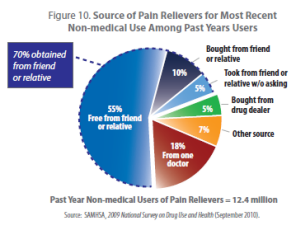
While safe disposal of prescription drugs is an important tool in preventing prescription drug abuse, there is also a critical need to stop prescribers who improperly and dangerously prescribe vast quantities of controlled substances. In June 2010, as part of “Operation Compound Fracture,” DEA, the Internal Revenue Service (IRS), and local police identified and obtained the conviction of the doctor behind a “pain clinic” that had used Internet sites to distribute 7 million tablets of prescription drugs without proper prescriptions from 2001 through 2007. The “pain clinic” owner, who faces up to 20 years in prison upon sentencing, was convicted of conspiracy to manufacture, distribute, and dispense a controlled substance not for a legitimate medical purpose; money laundering; and the spending of illicit proceeds. In March 2010, DEA and Federal, state, and local law enforcement agencies, served immediate suspension orders on six doctors, who were among the top 20 doctors dispensing the most oxycodone in the United States in 2009. (Action Item 2.2D)
Federal law enforcement agencies continue to improve efforts to crack down on ‘rogue’ pain clinics. DEA is exploring and applying best practices to better identify these clinics. This effort will enhance existing databases to improve the investigative tools and information available to field offices, and thereby better support enforcement activities and prosecutions. Also, under its Distributor Initiative, DEA continues to apprise wholesale distributors about current methods of diversion and to remind them of their responsibilities to identify and report suspicious activity. (Action Item 2.2F)
As part of its ongoing effort to drive illegal pharmacies out of business, DEA’s SOD has also met with Internet industry representatives including Internet Corporation for Assigned Names and Numbers (ICANN), Regional Internet Registries, Registrars, Webhost Providers, and the three largest Internet search engine companies to jointly determine best practices for blocking rogue Internet pharmaceutical sales. (Action Item 2.2E)
Marijuana on Public Lands
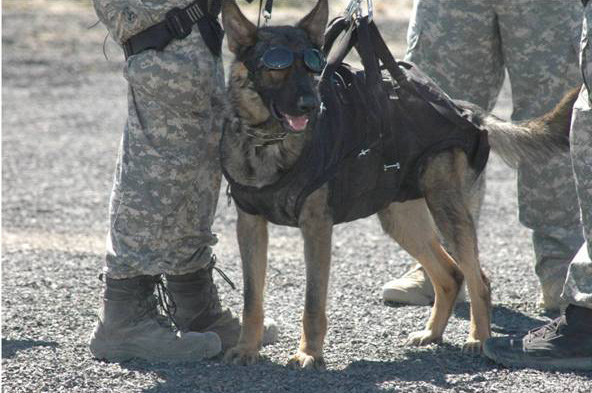
Marijuana cultivation on public lands is particularly damaging to both the environment and the public safety of the surrounding areas. Marijuana growing operations commonly degrade local ecosystems, clearing native brush, diverting water resources, and using banned pesticides. Further, the potential for harm to visitors and management staff is a major safety concern. Members of the drug trafficking organizations involved in these marijuana growing operations are often armed and dangerous. They protect their illegal marijuana operations through the use of force and intimidation. Such incidents have increased on public lands in recent years. There were nine shootings on public lands in California in 2010, compared to only one such shooting in both 2008 and 2009.
In an effort to address marijuana cultivation on public lands, the Public Lands Drug Coordination Committee, co-chaired by ONDCP and the Department of the Interior, brings together Federal agencies to develop policies and comprehensive strategies to substantially reduce the illegal production, cultivation, processing, and trafficking of marijuana on public lands. (Action item 5.3C)
As of November 2010, Operation “Trident,” an ongoing, multi-agency, marijuana enforcement effort in Madera, Fresno, and Tulare Counties, California, resulted in the eradication of approximately 664,000 marijuana plants, primarily from public lands, seizure of nearly 6,900 pounds of processed marijuana, arrest of 126 individuals and the Federal prosecution of 79 defendants. The success of this massive effort relied upon a coalition of agencies and programs, including members from Federal, state, and local law enforcement; public land agencies; California National Guard; California Drug Free Youth; High Sierra Volunteer Group; the U.S. Attorney’s Office; and the District Attorneys’ Offices. Based upon these successes, similar operations targeting marijuana growing operations will continue in 2011, with the goal of eliminating these illegal and dangerous operations on public lands.
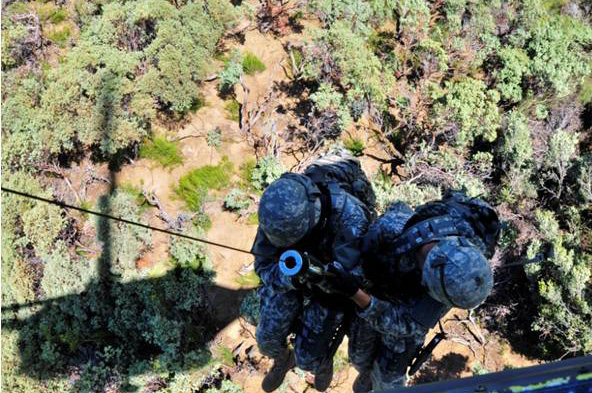
Combating Drug Gangs
In 2010, the FBI partnered with other Federal, state, and local officers to support 160 Violent Gang Safe Street Task Forces in targeted areas across the country. These task forces conduct investigations to disrupt violent gangs and prosecute gang members responsible for drug trafficking and distribution in their communities. Approximately 800 FBI Special Agents are working with 1,500 state and local officers and Special Agents from other Federal agencies to prevent violent gang-related crime. In addition, the FBI trained approximately 240 state and local Safe Streets Task Force Officers to further enhance investigative and enforcement capabilities. The Task Forces provide state and local law enforcement partners access to Federal investigative resources, the Federal judicial process and Federal prosecution for significant gang targets. These combined efforts are using the expertise and enforcement capabilities available to disrupt domestic drug trafficking and related crime. (Action Item 5.3E)
Operation “Community Shield” (OCS) is the ICE-led National Gang Unit that connects ICE’s criminal and administrative enforcement authorities with state, local, and tribal law enforcement agencies to combat the growth and proliferation of transnational street gangs in communities throughout the United States. More than 350 ICE agents are involved in this effort, working with other law enforcement stakeholders to locate, investigate, prosecute and, if appropriate, remove gang members from the United States. Since the inception of OCS, ICE annual criminal arrests of gang members has grown from 306 in 2005 to more than 2,600 in 2010. The OCS program has been responsible for the arrest of more than 20,000 gang members or their associates. In addition, OCS agents have been responsible for seizing more than 1,700 firearms from the hands of gang members and their associates.
In 2010, ICE conducted Project “Southern Tempest”, an anti-gang initiative that included enforcement actions in 168 U.S. cities and involved the efforts of 173 other Federal, State, and local law enforcement agency partners. The operation resulted in the arrest of 678 gang members and associates and the seizure of 86 firearms. Nearly half of those arrested during this operation were members or associates of gangs affiliated with Mexican DTOs, and 322 had previous violent criminal histories.
In 2010, the Department of Justice established a partnership between the National Gang Targeting, Enforcement, and Coordination Center (GangTECC) and SOD. Under the terms of that partnership, which became effective with the signing of a charter and memorandum of understanding in July 2010, GangTECC became a unit under the operational lead of SOD. The GangTECC unit is positioned to expand coordination efforts, link and deconflict gang cases, and share investigative intelligence
Financial Investigations
In 2010, Federal, state, local, and tribal law enforcement partnered to deny drug traffickers almost $3 billion in currency, property, and drugs. OCDETF component agencies conducted operations to disrupt drug traffickers’ smuggling of bulk cash. Efforts in the OCDETF Great Lakes, Mid-Atlantic, New England, New York/New Jersey, Southwest, and West Central regions opened 44 new investigations, secured 67 new indictments against 247 defendants, and obtained convictions of 194 defendants previously charged. (Action Item 5.3F)
On June 2, 2010, DHS released the Bi-National Criminal Proceeds Study (BNCPS) at a U.S.-Mexico Money Laundering Conference in Mexico City. The purpose of the study was to provide a strategic-level analysis of the processes and methods used by transnational criminals, particularly drug trafficking organizations, to repatriate illicit money from the United States into Mexico and other countries. Information collected from the study is being used by both the U.S. and Mexican Governments to deny criminals the ability to move money, and to ultimately dismantle their operations.
Operationally, ICE coordinated a summer financial investigative surge in furtherance of their enhanced investigative efforts targeting Mexican Criminal Enterprises (CEs) entitled Operation Overload. ICE special agents, CBP officers, and our Mexican counterparts collaborated to initiate joint enforcement initiatives targeting the movement of illicit proceeds into out of and through the United States and Mexico via physical (i.e., air, sea, and land ports of entry) as well as electronic (i.e., banks, money service businesses, etc.) modes of transmission. These surge efforts resulted in the initiation of 56 financial investigations, 104 arrests in both the United States and Mexico, and the seizure of over $23.5 million in illicit proceeds.
In 2011, the Administration will publish the National Bulk Cash Threat Assessment, identifying major bulk currency collection hubs, transit routes, and stash locations throughout the United States. This important tool for all levels of domestic law enforcement and the Nation’s intelligence community will improve allocation of investigative and enforcement resources and better target the highest priority drug trafficking threats. (Action Item 5.3F)
The Department of Treasury’s Financial Crimes Enforcement Network (FinCEN) has built upon its relationships with authorities in all 50 States to support local law enforcement efforts to disrupt drug traffickers’
financial operations. FinCEN continues to use this network of contacts to more systematically obtain information from law enforcement agencies about criminal organizations and their financial activities. FinCEN is also working jointly with the government of Mexico to more accurately and efficiently report cross-border money flow trends and has increased its level of direct strategic coordination and information sharing. These accomplishments are a testament to the capabilities of targeted, collaborative enforcement efforts in disrupting domestic drug trafficking.
DEA has established a broad-based approach for investigating and disrupting illicit financial networks located throughout the United States and globally. By targeting the flow of revenue back to the narcotics sources of supply, DEA is able to hinder the financing of subsequent cycles of illicit drugs destined for the United States. Domestically, DEA conducts complex investigations aimed at identifying, documenting, and prosecuting major drug-money laundering and threat finance organizations. Financial Investigation Teams (FITs) have been established in all 21 DEA Domestic Field Divisions throughout the United States to assist in carrying out DEA’s Global Financial Attack Strategy. Additionally, DEA builds capacity amongst other Federal, state, and local law enforcement agencies and interacts with the financial services industry regarding money laundering and threat finance matters.
One of the core goals of ICE is to target cross-border smuggling organizations and the organizations’ illicit proceeds used to fund their criminal activities. ICE employs its expansive investigative authority and the largest force of investigators within DHS to protect the United States against transnational criminal networks and terrorist organizations that seek to exploit our borders and America’s legitimate trade, travel, and financial systems.
National Parcel Post Initiative
In addition to targeting individual drug threats, domestic enforcement agencies are employing innovative tools to disrupt trafficking networks. One forthcoming domestic enforcement tool is the development of the National Parcel Post Initiative. (Action Item 5.3G) This initiative will help state and local law enforcement identify suspicious packages, analyze emerging trends in parcel post trafficking and interdiction, and learn about the appropriate procedures and guidelines for these types of investigations. The U.S. Postal Service (USPS), ONDCP, DHS, and private mail delivery services are developing a nationwide training effort for law enforcement officers so they can effectively counter the emerging trend of using mail couriers to traffic and distribute drugs. In addition, CBP, USPS, and Royal Mail (UK) have joined to implement a pilot program in 2011 to develop an inbound mail manifest system to identify and target suspicious international packages in airports.
Drug Endangered Children
Substance abuse has a devastating impact on families. Parental substance abuse is the primary reason for removal in 33.8 percent of cases involving children under one, and a quarter of cases involving children ages 2 to 8. Separating a child from his or her parents should be a last resort. Multi-system approaches should be employed to assess the needs of the family. When indicated, parents should receive treatment and other services to strengthen the family unit. Effective comprehensive treatment that supports families will need to target the multiple needs of infants, young children, and their families. This will mitigate the need for separation of parents and their children. The building of collaborative relationships among family-serving agencies, the assurance of timely access to comprehensive substance abuse treatment services, the improvement of the ability to engage and retain clients in care and to support ongoing recovery, the enhancement of children’s services and the filling of information gaps are all identified as important actions that must occur in order to improve outcomes for vulnerable children and families affected by substance use. For example, family drug courts and family-based treatment programs benefit children, families, and communities by diverting involvement in the criminal justice or child welfare systems and addressing needs in a holistic, family-centered way.
The 2010 Strategy called for a Federal interagency task force for Drug Endangered Children (DEC) to address drug use and its impact on children in a broader context. The term “drug endangered children” emerged during the dramatic increase in methamphetamine use and production in the 1990s, when children were found in homes where methamphetamine production caused toxic environments and caused abuse and neglect. The Task Force, established in May 2010, immediately expanded the definition of drug endangered children to include any person under age 18 affected by the production, distribution, and use of any drugs. This includes children who live in or are exposed to an environment where drugs are present, along with the associated physical, sexual, or emotional abuse, neglect, or other possible harms to their health and well-being.
In 2011, the task force plans to promote practices to prevent, intervene, and correct the profound harm that can result from drug use and its associated crime and violence. The task force is developing information on promising practices, as well as resource cards, reporting forms, and medical checklists for law enforcement, educational workers, and child protective services practitioners. These materials will be made available online and the cards, forms and checklists will be downloadable for mobile use. This will enable first responders, and adults who are responsible for children in other contexts, to conduct better assessments of children at risk and determine the appropriate actions to be taken. The DHS Federal Law Enforcement Training Center will provide training for first responders and multidisciplinary teams from states, localities, and tribal areas. (Action Item 5.3H)
All of these efforts will help reduce the profound devastation drug use and related crimes have on children.
